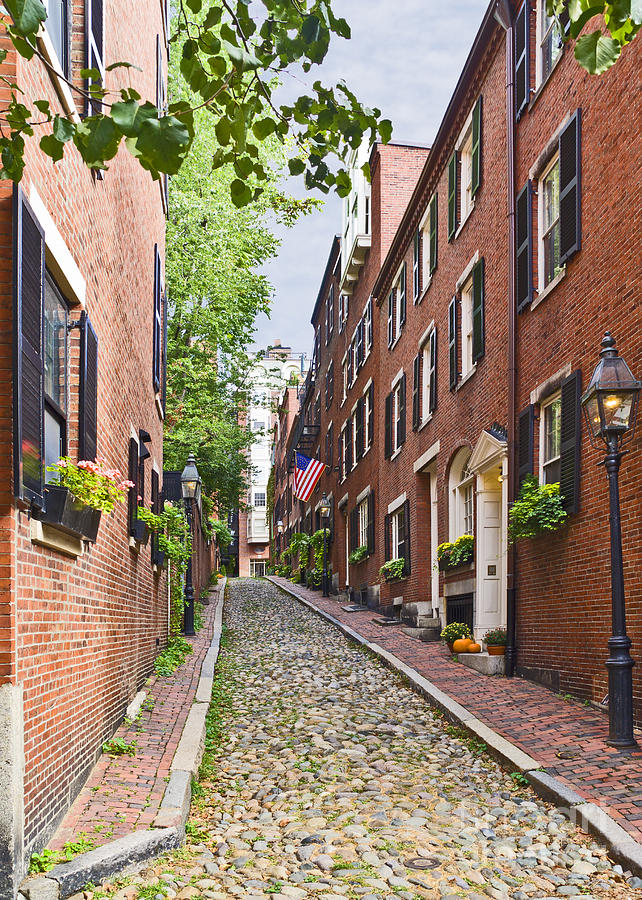

Perhaps you will hear a mother calling her children, the tap of a quiet stranger at the door, or a song … perhaps you will hear a bit of that history. Stop and listen as you walk along Acorn Street. As with most homes on Beacon Hill, the houses along Acorn Street have been updated within, and command top price for location and for quality. These days, Acorn Street is a residential area, open to all. They supported schools and churches, helped friends and strangers, and built lives for the future. There were the cobblers, chimney sweeps, carpenters, cooks, gardeners, and other trades people who were parents, grandparents, aunts, uncles, and friends to these children and to each other, working out their day to day lives Born free or born enslaved, speaking out or staying quiet, they worked and lived together as part of an active and thriving African American community of free people in challenging times. I think about them, and the others who walked this street and crossed these doorsteps through the years. I sometimes think about how those children may have felt, all the ones attending the different schools. It was one of the city’s first integrated schools. In 1855 when the Massachusetts legislature did away with segregated schools, the children of Acorn Street may have been among those who attended Phillips School, nearby on Anderson and Pickney Streets. They likely sent their children to school first at the Meeting House, and later at the Abiel Smith School. On a less dangerous note, families might have grown food in the small enclosed gardens along Acorn Street. James Scott and John Coburn were among those in the neighbourhood who were arrested for such activities. who had themselves escaped from slavery in Kentucky, made their house on nearby Phillips Street a stop on the underground railroad as well. Smith, whose barber shop became a spot for people to meet and exchange information. A number of Black and white Bostonians continued to do this work, though.Īmong them were folk who lived just a street or two over from Acorn Street, among them John J. When the Fugitive Slave Law, which required fugitive slaves to be returned to their owners, came into effect across the country in 1850, such activities became even more dangerous than they already were. As slavery had been abolished in Massachusetts in 1783, the state was a frequent destination and way stop for those fleeing slavery. People who worked with and helped the underground railroad were active on this part of Beacon Hill, too. Some forty years later, an African Methodist Episcopal (AME) congregation bought the building and remained there until 1939. In the 1830s, Timothy Gilbert, a white abolitionist, went against the tradition of his white Charles Street Baptist Meeting House nearby by inviting Black friends to sit with him. Though its residents were not enslaved, they lived in times when many Blacks in the country were, and when tensions were high.

Not all was peaceful around Acorn Street. They could have done so at the Meeting House, which for a time served as a recruiting station. Perhaps some of the men from Acorn Street signed up to join the 54th Massachusetts Regiment of the Union Army during Civil War days. William Lloyd Garrison spoke at the African Meeting House. Those who lived along Acorn Street might have walked a few blocks to attend services or hear talks at the African Meeting House. Many free Blacks who lived along Acorn Street and nearby worked in those homes. Further up Beacon Hill were homes of wealthy white families. In the years before the Civil War, this area of Beacon Hill was part of a large African American community. They were not, however, enslaved people, though it is likely some had been. They were artisans, craftspeople, and servants. That was true for those who came to live and raise their families along Acorn Street. Many of the streets, and the buildings which surround them, came to be in times in the early part of the nineteenth century when foot, horse, wagon, and buggy, were main means of getting around. Beyond the day to day happenings of a modern residential street and the nearby bustle of the Massachusetts State House and Boston Common, you may just be able to hear their stories. Stand still and listen when you visit Acorn Street. People who lived along Acorn Street in the past had their parts to play in history, and that may not have been quite what you expect. You may have seen its cobblestones or red brick walls as backdrop to an advertisement or a fashion shoot.ĭo you know the backstory of this street the Beacon Hill area in Boston, though?


 0 kommentar(er)
0 kommentar(er)
